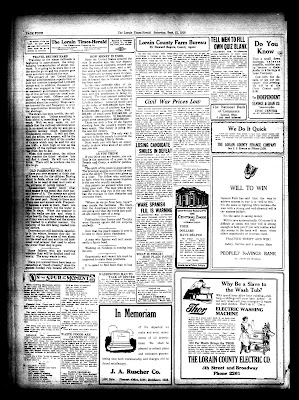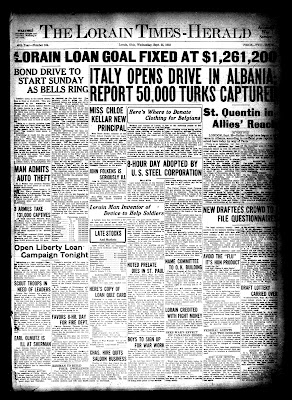The 1918 flu pandemic took a great toll on the City of Lorain.
How bad was it? According to an article that appeared in the Journal on July 18, 1959, more than 200 deaths resulted out of the 2,500 reported Lorain flu cases. (For comparison, there have been between 185 and 200 Coronavirus deaths in all of Lorain County since the pandemic began in 2020.)
Watching the 1918 Spanish flu pandemic unfold in the pages of the Lorain Times-Herald is fascinating, especially in comparison to what we have been living through since March of last year with Covid-19.
It is generally accepted that the first wave of the Spanish flu occurred in Europe in the spring of 1918. However, while quickly scanning front pages of the Times-Herald on microfilm, I could find no mention of it through the spring and summer. This could be due to the fact that World War I was still raging and news of it was occupying most of the front pages, or perhaps because of the limited news reports as to what was going on in Europe.
It wasn’t until the September 21, 1918 edition that I noticed a small article, about halfway down on page four.
“Reports from some European countries indicated that 20 percent of the population has been affected this summer by Spanish influenza,” it noted.“Sur. Gen. Blue said today in reminding the public that it was well not to underrate the disease. While the epidemic is some places has been mild, it was attended in others, he said, by considerable mortality. A fatal outcome is not uncommon, the surgeon general said, when the infection takes the form of pneumonia.
The Surgeon General even offered a little poem instructing how to combat the influenza. “Cover up each cough and sneeze for if you don’t, you’ll spread disease.”
A few days later, the flu made the front page near the bottom of the September 25, 1918 edition. Unfortunately, the almost comical assertions made in the article belied the threat that would soon be all too real.
Although the article observed that Spain was unfairly being blamed for the flu, a few kooky theories were offered as to how to deal with it.





Wow - this is fascinating. Thanks!
ReplyDelete